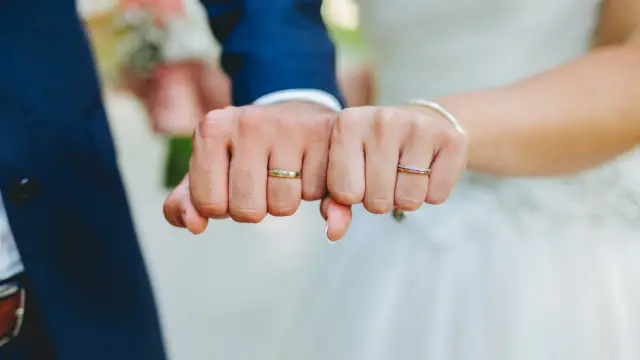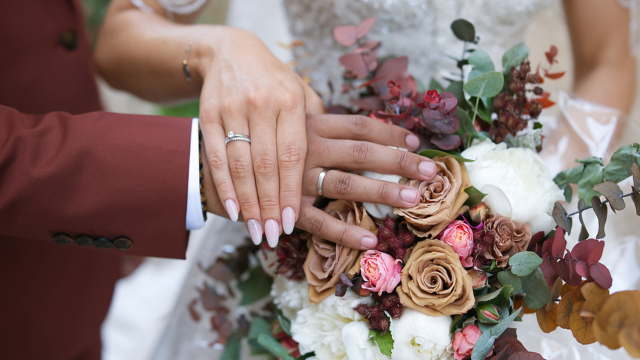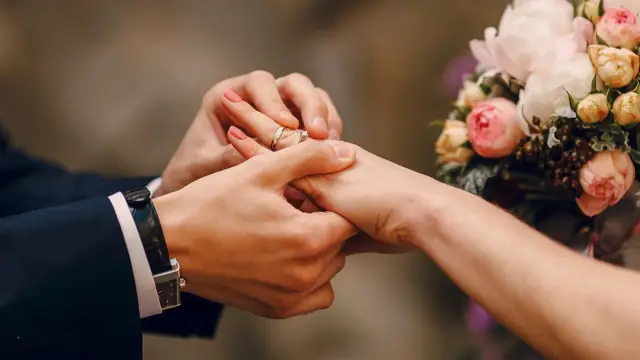What Hand Does a Wedding Ring Go On? The Ultimate Guide
What Hand Does a Wedding Ring Go On may be the next burning question as you inch closer to the big day, while you are probably already swamped with a million decisions, from cake flavors to dance playlists.
We’re here to guide you through this age-old tradition and shed light on the intriguing customs worldwide. Whether you’re a stickler for traditions or marching to the beat of your drum, this guide will show you the way.
What Is The Tradition In The US?
In the United States and most Western countries, wedding rings are typically worn on the fourth finger (ring finger) of the left hand, a practice that is believed to have originated in Egypt and was adopted by the Romans based on a belief that a “vena amoris,” or “vein of love,” runs from this finger directly to the heart. This romantic notion has endured through the centuries, making the left ring finger the most popular choice for wedding ring placement.

Why Does It Matter Which Hand?
Positioning a wedding ring on your left or right matters for many couples, as it has deep roots in symbolism and tradition. In many cultures around the world, there’s an important significance behind which hand is chosen for wearing these cherished pieces of jewelry. For example, in some parts of Europe and South America, the left hand is associated with the heart. Therefore, in these regions, a wedding ring is worn on the fourth finger of the left hand.
Is It OK To Switch Traditions?
Of course! Ultimately, modern times have made traditional rules more flexible – so if you’d rather wear your wedding ring on the right hand, feel free to do so. Many couples today opt for a more unconventional approach and break cultural norms for their special day. There is no wrong answer when it comes to where you place your rings – as long as it feels right for you and your partner!
Some countries, such as India, Germany, and Norway, may opt for the right hand. As you prepare for your wedding and decide on the details, you’ll find that the choice of which hand and finger to wear your ring ultimately comes down to what feels suitable for you and your partner and what aligns with your cultural or personal beliefs.
Selecting Practicality: Which Hand to Wear a Wedding Ring On
Sometimes, life’s daily rhythms can influence which hand feels right for that precious band.
Your Day-to-Day Matters!
- To the Hardworking Manual Workers: If one of you is on the construction site, in a workshop, or dealing with heavy machinery, think about the non-dominant hand. It might be less risky. Have you ever considered silicone bands for work hours? They’re both stylish and safe.
- Calling All Doctors and Healthcare Heroes: The demands of your job, from constantly washing hands to slipping on gloves, might make wearing a ring a tad tricky. Some in your profession wear their rings on chains around their necks during those busy shifts.
- Artists: Whether molding clay, crafting beautiful canvases, or playing sweet melodies, the ring shouldn’t come in the way of your art. Perhaps the non-dominant hand or even a different finger entirely might feel right.
Variation Across Cultures
When it comes to wearing a wedding ring, different cultures have varying traditions and reasons behind the hand and finger they choose. Let’s delve into the practices of these diverse cultures and explore the reasons behind their differences.
In Western cultures, including the USA, UK, and many European countries, such as France, Germany, Spain, and Italy, the tradition is to wear the wedding ring on the fourth finger of the left hand. This practice dates back to ancient Rome and ancient Egypt where it was believed that the “vein of love” (vena amoris) ran directly from the fourth finger of the left hand to the heart.
In Russia, Austria, and Poland, it’s common to wear the wedding ring on the fourth finger of the right hand. Similarly, in some cultures like Greece, India, and Brazil, the tradition is to wear the wedding ring on the right hand. Greek Orthodox Christians, for example, place wedding rings on their right hand because Orthodox Christianity regards the right hand as more honorific.
In Norway, wedding rings are traditionally worn on the right hand, but in recent years, some couples have adopted the Western custom and wear their rings on their left hand. Some indigenous North American cultures also have unique wedding ring traditions that reflect their history and beliefs.

Overall, the hand and finger on which you wear your wedding ring can be deeply rooted in your culture, religion, or personal preference. As the world becomes increasingly interconnected, you may witness diverse wedding traditions merging or evolving to reflect the changing nature of our global community. So, whether you follow your culture’s practice or mix it up, the choice ultimately comes down to what feels meaningful to you and your partner.
What Hand Does a Wedding Ring Go On – How do wedding ring traditions differ by country?
- USA:
- Hand & Finger: Left hand, ring finger
- Material/Design: Gold, often with diamonds for engagement rings
- Tradition/Notes: Both engagement and wedding rings are common; the engagement ring often features a diamond.
- UK:
- Hand & Finger: Left hand, ring finger
- Material/Design: Typically gold or platinum
- Tradition/Notes: Men often wear a plain band.
- Russia:
- Hand & Finger: Right hand, ring finger
- Material/Design: Gold or silver
- Tradition/Notes: Typically a plain band.
- India:
- Hand & Finger: Left hand, ring finger
- Material/Design: Gold adorned with precious stones
- Tradition/Notes: Rings are just one part of the extensive jewelry worn at weddings.
- Germany:
- Hand & Finger: Right hand, ring finger
- Material/Design: Gold
- Tradition/Notes: The engagement ring is worn on the left hand and moved to the right during the wedding.
- Brazil:
- Hand & Finger: Right hand, ring finger
- Material/Design: Gold
- Tradition/Notes: Like in Germany, the engagement ring is worn on the left and moved to the right during the wedding.
- Norway:
- Hand & Finger: Right hand, ring finger
- Material/Design: Gold or white gold
- Tradition/Notes: No specific notes.
- Greece:
- Hand & Finger: Left hand, ring finger
- Material/Design: Gold
- Tradition/Notes: No specific notes.
- South Africa:
- Hand & Finger: Left hand, ring finger
- Material/Design: Gold, often with diamonds
- Tradition/Notes: No specific notes.
- Japan:
- Hand & Finger: Left hand, ring finger
- Material/Design: Platinum, often with a diamond for engagement rings
- Tradition/Notes: Engagement rings often feature a diamond.
- China:
- Hand & Finger: Left hand, middle finger
- Material/Design: Gold and sometimes jade for engagement
- Tradition/Notes: Gold is standard for wedding rings, while jade is sometimes used for engagement.
- Jewish Tradition:
- Hand & Finger: Right hand, index finger
- Material/Design: Plain gold band
- Tradition/Notes: The ring is placed on the index finger during the ceremony, then often moved to the ring finger afterward.

Wedding Ring Traditions by Hand
Wedding customs, including the hand on which the wedding ring is worn, can vary significantly from one country to another. While the left hand is preferred in some nations, others have traditions that place the ring on the right hand. The following table provides a snapshot of these preferences across various countries:
| Left Hand | Right Hand |
|---|---|
| United States | Russia |
| Canada | India (some communities) |
| United Kingdom | Greece |
| Australia | Norway |
| South Africa | Austria |
| Ireland | Poland |
| New Zealand | Bulgaria |
| France (traditionally) | Germany |
| Spain (Catalonia region) | |
| Brazil (some regions) | |
| Ukraine | |
| Denmark | |
| Hungary | |
| Venezuela |
While this table captures general trends, individual choices and regional variations within countries may deviate from these norms.

Finger Selection: Left vs. Right Hand
Cultural and regional traditions play a significant role when deciding which hand and finger to wear your wedding ring on. But people wear wedding rings on their preferred fingers for personal or practical reasons. For example, if your ring finger is injured or for some other reason, you might wear your wedding ring on your index finger, middle finger, or thumb instead.
Regardless of the hand or finger you choose, it is your preference. As long as the ring symbolizes your commitment and love, it doesn’t matter which hand you wear it on. The important thing is to make sure that the wedding rings are comfortable and fit properly so they can be worn with pride every day!
Engagement vs. Wedding Ring: At a Glance
An engagement ring and a wedding ring—aren’t they the same thing? Spoiler alert: Nope, they’re not!
| Aspect | Engagement Ring | Wedding Ring |
|---|---|---|
| Primary Purpose | Symbol of intent to marry | Symbol of eternal commitment |
| Typical Design | Flashier with gemstones | Simpler, often band-style |
| When It’s Given | At the proposal | During the wedding ceremony |
| Who Wears It | Typically the bride-to-be | Both partners |
Wedding Ring Basics
Whichever hand you decide to wear, wedding rings are generally simpler and are designed to be worn all the time. They’re like that comfy pair of shoes that go with everything. It’s a piece of everyday elegance. The magic lies in the simplicity.
How They Pair Up: Engagement Ring Meets Wedding Ring
So, after the wedding, what happens? Do you still wear your engagement ring? Absolutely! Many people wear both, stacking the engagement ring above the wedding ring. Some even get them soldered together for a permanent love combo!
Top Advice for Pairing Rings
- Match Metals: If your engagement ring is platinum, go for a platinum wedding ring.
- Think of the Future: You’ll wear your wedding ring forever, so pick something timeless.
- Fit Matters: Both rings should be comfortable and complement each other.

The Wedding Ceremony Ring Exchange
The time to exchange rings is typically done after the vows as a way to seal the promises you made to each other.
During the ring exchange, you and your partner will take turns placing the rings on each other’s chosen fingers while stating your commitment and love.
The officiant generally provides guidance on which hand a wedding ring should go on.
The words spoken during this part of the ceremony can be your own or follow traditional phrases provided by the officiant. The ring exchange is considered the culmination of the wedding ceremony, symbolizing the bond between the bride and groom as they embark on their journey as a married couple.
Frequently Asked Questions
Which hand does a man wear his wedding ring?
Traditionally, men in the US wear their wedding ring on the fourth finger of the left hand. The traditions go back to the Roman belief that a vein in this finger, known as the “vena amoris” (Latin for “vein of love”), ran directly from the fourth finger of the left hand to the heart. However, some men choose to wear their rings on their right hand due to cultural differences or personal preference.
Do engagement and wedding rings go on the same finger?
Yes, engagement and wedding rings typically go on the same finger. Engagement rings are usually worn after the proposal, and wedding rings are added during the wedding ceremony. It’s common for people to wear both rings on the fourth finger of the left hand, stacking the wedding ring beneath the engagement ring.


